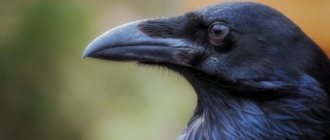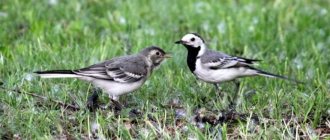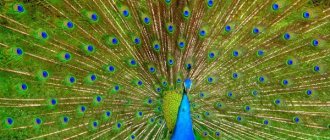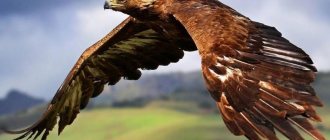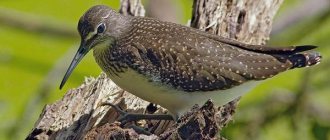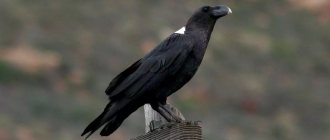Appearance
The largest species in the family, body length reaches 90 - 129 cm, body weight of males - 3500-6180 g (females - 2230-4580 g), wing length from 49.5 to 61.8 cm. The color of the plumage is black, the primary flight feathers are white . Males have bare patches of bright red skin around the eyes and on the throat; females have a black spot against the background of the red throat. Young birds are brown, with areas of bare skin colored gray-brown. Horned crows reach sexual maturity at 4–6 years of age and by this time have acquired adult coloration.
Description and varieties
The Kaffir Raven is the sacred bird of Africa. Distinctive characteristics of the bird:
- Body length – 1 m.
- The weight of a male is 4-6 kg, a female is 2.5-4 kg.
- Like most ravens, it has jet-black plumage, but around its eyes there are “spectacles” of bare red skin. Young birds are recognizable by the fact that their “frame” is rich yellow.
- The chicks are brown in color, which after molting takes on a sooty color.
- The black beak is straight, has a distinctive feature of all rhinoceroses - a “helmet”, by which males can be distinguished from females - the “helmet” of the latter is less developed.
The beak with a “helmet” is the main decoration of the African horned bird.
Please note! They make very loud sounds, similar to the roar of lions and can be heard at a distance of more than 5 km.
Abyssinian
This is a large species of raven, the closest relative of the Kaffir raven. The second name of the species is northern. Lives in Africa, in savannas located in Senegal, Kenya, and Somalia. The body length often exceeds 1.3 m, the wingspan is more than 2 m. Moreover, the weight is relatively small for such sizes - 2.5-5 kg. This feature is associated with a light skeleton and the presence of subcutaneous air cavities.
The peculiarity of the Abyssinian raven is its large hollow beak filled with bone spongy tissue.
Lifestyle and social behavior
Horned crows lead a sedentary lifestyle. They live in small groups (from 2 to 11 individuals), consisting of a dominant pair of adult birds and their offspring, who remain with their parents after reaching sexual maturity. Young crows help their parents feed the chicks and protect the territory. The largest group recorded consisted of 11 horned ravens. Each group of horned crows protects its territory, the size of which varies from 2 to 100 km², patrolling its borders and emitting loud calls. In addition to screams, horned crows have more sophisticated ways to attract attention to themselves. For example, carefully holding an egg in its huge beak, the bird from the dominant pair manipulates it in front of the rest of the group.
Features of the behavior of a horned raven
The main activity of these birds occurs during the daytime. They usually live in family groups of up to 10 individuals - a married couple and their children, sometimes of different generations.
A pair of ravens and their offspring form a group
Everything in the family is very strict, children are respectful with adults, relationships are built on respect. The matured chicks help their parents raise the newly born babies.
There can be up to 10 individuals in a group
As soon as the head of the family reaches old age and becomes decrepit and weak, he is expelled from the pack. The vacated seat is taken by the eldest son. Other birds help the new leader in every possible way.
The old leader is driven out by a group of birds
The family of horned ravens occupies a fairly large area - up to 100 square kilometers. At the same time, they are not at all bothered by the presence of animals of other species, but they mercilessly expel their relatives.
All day long, horned Kaffir crows do nothing but look for food. These are mainly insects of all sizes, snakes, rodents, and occasionally fruits and roots.
Birds feed on insects, snakes and rodents
Nutrition and feeding behavior
The only true predator among hornbills. The main diet of horned crows consists of arthropods, in particular insects (grasshoppers, beetles, scorpions, termites). During the dry season, birds eat large quantities of insect larvae, mollusks, frogs, lizards, snakes (often poisonous), turtles, rodents, and sometimes even squirrels, young hares and mongooses. Horned crows spend most of their time on the ground, collecting food while walking slowly across the savannah. These birds are capable of eating almost any small animal that they can catch. Quickly grabbing prey from the ground, they kill it with strong blows of their beak and throw it into the air to make it easier to swallow. Horned crows hunt in groups of 2–8 birds (up to 11); they often pursue large prey together. They are the only hornbills that can pick up several food objects into their beaks without swallowing them and carry them to the nest. Sometimes they eat carrion, feasting on carrion-eating insects at the same time. They also eat fruits and seeds.
Habitat in nature
Horned crows are concentrated in Africa, but their habitat helps differentiate between the Kaffir and Abyssinian varieties.
Territory of residence
The kaffir bird is found in African savannas south of the equator, including Kenya and South Africa. Birds are also capable of rising to considerable heights: they have been spotted in mountains located at 3 km from sea level. Small groups are found throughout the continent, with the exception of the sands of the Sahara and tropical forests near the equator.
The bird prefers open spaces where it can hunt without much difficulty. The Kaffir Horned Crow is the only predatory member of its family. Occasionally it flies into the forests to feast on tropical fruits, most often it soars over the endless savannas.
The Kaffir Horned Raven may seem like a bizarre creature of nature, but it is a very beautiful bird, elegant in its own way.
What do they eat?
The raven's main food is insects and arthropods, of which there are a great many in savannas. The bird's hunting is interesting: the giant "rhinoceros" walks with a sedate step across the savannah, looking for beetles, termites, scorpions and mollusks, and then captures them with its sharp beak. In addition, it uses snakes, including poisonous ones, frogs, and rodents as food. A large raven is capable of catching even a medium-sized hare or mongoose.
Note! The horned raven quickly eats its prey, regardless of its size. And birds can catch large game together.
In times of famine, they eat carrion, as well as fruits and vegetables, and can also feed on corpse-eating insects.
Features of hatching chicks
This horned raven uses impressive-sized baobab tree hollows as a nest, practically without changing them, without walling them up. A male and a female take part in the construction of the nest. Mating games among horned crows take place infrequently, only once every 3 years, in the fall. After mating, there are 2 eggs in the clutch. The incubation is carried out exclusively by the female, but the care of her food is distributed among all members of the flock.
The birth of chicks is not a simultaneous event; often the older chick kills the weaker younger one. It's a rare family of ravens who manage to raise two babies.
The crows are ready for independent flight after 85 days. Birds become adults at 6 years of age.
Note! Such a long period of maturation is due to the fact that crows are real long-livers of the feathered world.
Migratory or not
The Kaffir horned raven is a sedentary bird, lives in Africa and is extremely reluctant to leave its native place. Birds prefer to live in unique families, which include up to 11 individuals: an adult parent pair and chicks of different ages. Young birds that reach 6 years of age most often leave their parents and create their own pairs.
Note! The young take part in feeding the chicks, hunting and bringing prey to the nest, and also protect the house from uninvited guests.
One family of horned crows requires a fairly spacious territory, from 5 to 100 square meters. km. Birds regularly fly around borders and drive away strangers with their unpleasant, sonorous screams.
Reproduction
The breeding season lasts from September to December. The nest of horned crows is usually located in the hollow of a large tree or in a depression among the rocks. Horned crows, the only hornbill, can occasionally independently dig a hole in the ground for it, but more often they use someone else’s abandoned nest. The male brings dry leaves and adds them to the litter, but the eggs are incubated only by the dominant female. However, unlike other rhino species, she can leave the clutch whenever she wants (since the male does not wall her up). A clutch can contain from 1 to 3 eggs; they are laid at intervals of 3–5 days. The female incubates the eggs for 37 - 43 days, and during this time she is fed by all members of the group. The chicks do not hatch synchronously, and the youngest often soon dies of starvation. It can only survive in years of abundant food. The chicks are fed 4–9 times a day by all members of the group. Interestingly, horned crows do not remove pellets and leftover food from the nest. The chicks fledge at 86 days of age and usually remain in the group until puberty or even longer. More often, young females leave the group. Horned crows reproduce very slowly, with an average of only 1 chick surviving every 9–10 years. However, the rate of reproduction may vary in individual groups: one raises a chick every 2 years, while another raises none in 20 years.
Features of the behavior of a horned raven
The main activity of these birds occurs during the daytime. They usually live in family groups of up to 10 individuals - a married couple and their children, sometimes of different generations.
A pair of ravens and their offspring form a group
Everything in the family is very strict, children are respectful with adults, relationships are built on respect. The matured chicks help their parents raise the newly born babies.
There can be up to 10 individuals in a group
As soon as the head of the family reaches old age and becomes decrepit and weak, he is expelled from the pack. The vacated seat is taken by the eldest son. Other birds help the new leader in every possible way.
The old leader is driven out by a group of birds
The family of horned ravens occupies a fairly large area - up to 100 square kilometers. At the same time, they are not at all bothered by the presence of animals of other species, but they mercilessly expel their relatives.
All day long, horned Kaffir crows do nothing but look for food. These are mainly insects of all sizes, snakes, rodents, and occasionally fruits and roots.
Birds feed on insects, snakes and rodents
The Story of Life at the Zoo
Once upon a time, only single specimens of Kaffir ravens were kept in the zoo. The couple is living together for the first time. The male lived alone for a year, then they got a female. Just by their appearance it is clear that this is a couple. Initially, they were kept in an enclosure together with African ostriches, since in nature these birds can live side by side, but after an injury to the ostrich, the birds were separated. The horned raven is not rare in zoo collections, but it is not found everywhere. This is a large bird with great destructive power, and zoos are not always ready to create strong enclosures for them. Bird behavior is complex, varied and intelligent. At the zoo, they know their zookeepers very well. The birds are constantly looking for various objects in the aviary, and when they find them, they show them to each other and begin to treat them to them. If one finds a bright pebble, he immediately runs and shows it to the other. Their beak is blunt (not sharp), but its blow is very strong. Crows easily dismantle the decorations in the enclosure, including concrete ones, leaving only the reinforcement. Feeding twice a day. In the morning - mice and quails, which the staff hide throughout the enclosure - in hollows, under stones, between branches, so that the crows are busy searching for food. For lunch - either insects, which are placed in a plastic bottle, or nuts. These birds are also given a mash in the form of balls of meat, cottage cheese, rice, eggs and vegetables. When one ostrich felt bad and she lay down and did not get up, the crows were interested in her from a gastronomic point of view. Horned crows keep themselves busy with something all the time. We tried to place a crane with them, but we had to remove it from the enclosure. The crows were so busy with him that it began to threaten his life. Sometimes we give the crows a piece of watering hose to play with. For some time, the birds decide which side this “snake” will have its head on. As soon as they determine which one, they begin to “kill” her. “Kill” and wear it proudly. Food and stones are often offered to visitors through the bars. But don’t try to take it - they won’t give it to you.
TOP 10: Incredible facts about crows
Crows have long been associated with darkness, omens of trouble and death. Long before Poe immortalized ravens in the horror genre, they appeared in the Old Testament in connection with the destruction of the country by Edom. No one could survive in the smoldering ruins except the crows. It was great, but, as you understand, it did not help improve their image. Besides being perceived as harbingers of death and spooky Halloween decorations, crows are actually highly intelligent, adaptable and truly amazing creatures. 10. They are very smart
People have always known that crows are smart. This is nothing new. But we're just beginning to understand how smart scavengers actually are. It is believed that the intelligence of ravens is so developed that it can be compared with humans. The Corvid family, of which Ravens are a part, also includes crows, magpies, jays and jackdaws. All birds in this family are considered among the smartest in the world. A study published in Science in 2002 showed that the New Caledonian raven can bend a piece of wire into a hook to extract food from a narrow space. The same task was set for small children, and they were not able to show the same intelligence as our feathered friends.
A study carried out at Moscow University's biology department found that ravens were capable of logical reasoning after the birds were tested with a series of flash cards from which to choose. If the choice was correct, the raven was rewarded with mealworms. Choosing the right option is considered a higher level of analysis, and these birds already have this ability without the need for extensive training. Ravens have been seen gliding through the snow on homemade sleds made from bark, exploring man-made objects that come their way. They are creative and adaptable, and prove that you shouldn't be offended by the claim that you have a bird brain.
9. They have a special friendship with wolves
There is no doubt that wolves have the strength and intelligence that allows them to hunt on their own, but thanks to their feathered friends, this is not their best option. A recent study showed that within a minute of wolves taking down a wolf, the crows were already on it. By some estimates, a pair of wolves will lose almost 40 percent of the elk's meat to the ravens. If we are talking about six wolves, then the crows will get only 17 percent of the carcass. Although ravens and wolves may seem like bad partners, it is a mutually beneficial relationship, even if the wolves don't seem to benefit from it.
It makes sense for the ravens to follow the wolves and destroy the remains of their victims. One crow a day can destroy 1.8 kilograms from a 450 kilogram moose carcass. Now imagine what a few ravens could do. Scientists believe that this is why wolves hunt in packs. To increase their importance in this friendship, the crows lead the wolves to the carcasses of animals that the birds cannot eat because their beaks are not strong enough to handle the bodies of dead animals. When wolves hunt, ravens also warn them of suspicious sounds and potential danger.
8. They can talk
Although crows may appear to make a series of random "cries", these sounds are believed to contain meaning. In the wild, crows communicate with each other using a wide range of sounds. They can express emotions such as tenderness, happiness, anger and surprise. They can also warn each other of danger by clucking like chickens and making trills when ready to fight. They have a certain "kar" sound that they use when talking about meat. Each of their social groups has their own dialect. In captivity, crows can learn to speak better than many parrots. Human speech is not the only thing these guys can imitate. Crows are able to imitate wolves (which comes in handy when trying to lead them to carcasses that crows cannot tear apart on their own), other birds, garbage trucks, and a toilet barrel.
7. They are often seen as an omen.
Photo: whats-your-sign.com
This may be due to their night-black plumage, or their habit of circling over corpses. Whatever the reasons, crows have played a key role in mythology and superstition since ancient times. In Celtic mythology, ravens were considered an omen of battle and bloodshed.
The Irish believed that the goddess of war sent ravens from heaven to eat the corpses of the fallen. It made sense, because that's what ravens do, whether the goddess wants it or not. Hindus believe that ravens are the souls of the dead. In Germany they believe that ravens hold the souls of the damned. The Arabs call the raven "Abu Zakir" ("Father of Omens"). Swedish folklore tells us that ravens are the ghosts of those who were killed and would not have been given a proper burial.
6. They enjoy being in an altered state of consciousness.
Photo: besgroup.org
This does not mean that they take a puff on a joint; such behavior is not their style. What they are enjoying is quite strange: they are participating in something that can be called ant therapy. It involves crushing ants and smearing them over the crows' bodies. When crushed, the ants release formic acid, which the birds' skin absorbs, which they seem to like. Why do they do this? No one knows for sure, but there is no shortage of theories. One of them suggests that ant therapy is a form of preparing the bird’s body for future prey, which develops immunity to formic acid in crows. This way, birds can then eat ants without any side effects.
Some people believe that ant therapy is an acquired habit. Others believe it is instinct. Maybe the formic acid acts as a kind of bath oil and has a soothing effect on the skin. Birds that participate in ant therapy exhibit complete bliss. Everything is possible, it really is that simple. We humans have a tendency to over-eager to find signs of intelligence. Perhaps the real reason crows and other birds cover themselves in squashed ants is because they simply get a kick out of it.
5. They know how to empathize
Photo: calacademy.org
Although a group of crows look aggressive, they are actually very compassionate. A study published in the journal PLOS One in 2010 found that crows comfort the victim of an act of aggression. Over the course of two years, Orlaith Fraser and Thomas Bugnyar observed the behavior of 13 tame crows. During this time, researchers observed 152 battles. They classified ravens as aggressors, victims and bystanders depending on their role in the altercation.
Crows that spent the most time with victims showed the greatest degree of compassion, which was expressed by touching their beaks and bodies, sitting next to the victim, and accompanying them. Observers noticed that the victim felt unhappy. We had not previously suspected that crows undergo higher thought processes associated with empathy. To show empathy, they must be able to understand the situation and then exhibit certain behaviors towards the victim.
4. They are real pirates
They may not plunder or pillage the seas and oceans, but they do have a couple of skills that are important to any true pirate. Some of these skills are the ability to bargain and the ability to think ahead. In an experiment conducted by Can Kabadayi and Mathias Osvath at Lund University in Sweden, crows were shown to have the cognitive ability to plan ahead and bargain for what they want. Kabadayi and Oswath trained a group of ravens to use a specific tool on a box to get a treat out of it. The researchers then removed the box and returned an hour later with several items from which the crows had to choose.
One of the items was the very tool with which one could open the box. Eighty percent of the time, the crows chose the tool and were able to complete the task to receive a treat when the box was returned to them 15 minutes later. After 17 hours, the experiment was repeated, and after 90 percent of the time the crows completed the task correctly. The birds also used tokens that they could exchange for food. Another feature that makes ravens a much better bird to sit on a pirate's shoulder than a parrot is their intolerance of deceivers. Researchers at Lund University in Sweden conducted an experiment that involved haggling with crows, then tricking them and seeing if they remembered it. They remembered.
At the first stage, one researcher handed the raven a piece of bread, which he could exchange for a more attractive piece of cheese, which was held by the second researcher. At the next stage, the raven brought bread to the second researcher for exchange. But instead of giving the cheese, the researcher stuffed a piece of delicious cheese into his mouth. A couple of days later, the experiment was conducted again, but with the participation of a third neutral researcher. The crows had not worked with this man before. Six of the seven birds chose to deal with the explorer they considered "fair" (the one who didn't eat the cheese), and one of the ravens chose the "neutral" explorer. A month later, only one chose the "unfair" researcher, while the others still didn't trust him. If crows could force someone to walk on nails, the “unfair” explorer would be the first.
3. Crows defend the Tower of London
Photo: The Telegraph
Although no one knows where the rumor came from, the presence of ravens in the Tower of London is believed to ward off trouble. If the ravens ever leave the tower, it will collapse along with the English monarchy. One theory attributes the authorship to Geoffrey of Monmouth, who wrote about King Bran Hen of Bryneich. Bran, which means "raven" in Welsh, asked that his head be buried in the tower as a talisman to ward off invasion. Crows have lived there ever since. In 1661, Charles II ordered that six ravens be kept in the tower at all times. They're still there.
2. They are crafty
Photo: avesnoir.com
The cunning and cunning of ravens has long been described in mythology and associated with knowledge. Many Native American tribes believed that the raven was a skilled deceiver and could even change shape. The raven is quite easy to follow. The Sioux Indian tribe has a legend about a white raven who warned a buffalo that hunters were hunting near him, which allowed the buffalo to escape. According to legend, an angry shaman threw the bird into the fire, causing the raven's feathers to turn black.
As scientists closely study ravens, they note that they are quite cunning. A study conducted by the University of Vermont found that young crows will fuss over a carcass to get other young crows to join them. This helps ensure their safety against adult ravens and other scavenger birds. It has also been discovered that crows are able to pretend to hide food in a certain place when it is in another, in order to throw others off the scent.
1. They are able to recognize and remember your face.
Photo: english-classics.net
The next time you're about to shoo crows out of your yard, stop and change your behavior. Ravens and other members of the Raven family are not going to forgive or forget. Wildlife biologist John M. Marzluff decided to test this idea on the University of Washington campus in Seattle. The Seven Thieves were tagged and released by masked explorers. Some campus residents wore scary masks while others wore neutral ones to provoke a reaction from the birds. Crows screamed and attacked people wearing “dangerous” masks.
Keep in mind that the researchers were not messing with the birds at this point, but were simply moving from one point on campus to another. The birds did not attack those who were wearing neutral masks. And soon they were left alone. At the same time, the crows told their friends about the “dangerous” masks, and they in turn told their friends. At one point, while Dr. Marzluff was walking around in his "dangerous" mask, 47 of the 53 thieves he encountered were ready to attack him.
It wasn't like that with Aesop. In his fable "The Fox and the Crow", an unsuspecting member of the Raven family takes the Fox's bait and throws her food, which she takes. The fox leaves after making some great remarks about the crow's intelligence. But if this were real life, the fox would not be able to enjoy the food. The bird would swoop down on the fox and grab the food, enlisting the help of an angry flock of crows.
